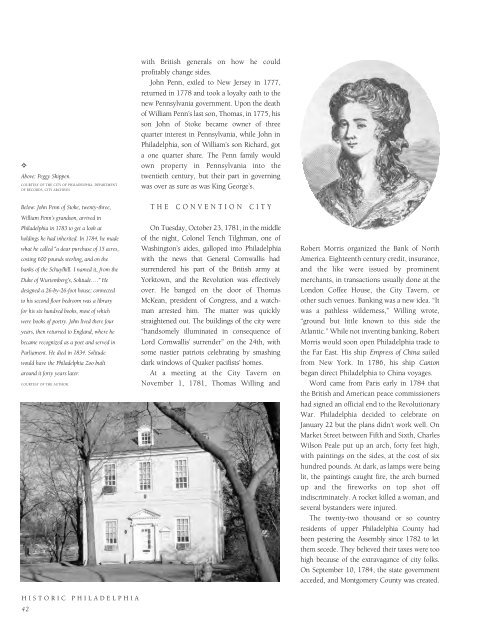Historic Philadelphia
An illustrated history of the city of Philadelphia, paired with the histories of companies, families and organizations that make the region great.
An illustrated history of the city of Philadelphia, paired with the histories of companies, families and organizations that make the region great.
Create successful ePaper yourself
Turn your PDF publications into a flip-book with our unique Google optimized e-Paper software.
✧<br />
Above: Peggy Shippen.<br />
COURTESY OF THE CITY OF PHILADELPHIA, DEPARTMENT<br />
OF RECORDS, CITY ARCHIVES.<br />
Below: John Penn of Stoke, twenty-three,<br />
William Penn’s grandson, arrived in<br />
<strong>Philadelphia</strong> in 1783 to get a look at<br />
holdings he had inherited. In 1784, he made<br />
what he called “a dear purchase of 15 acres,<br />
costing 600 pounds sterling, and on the<br />
banks of the Schuylkill. I named it, from the<br />
Duke of Wurtemberg’s, Solitude….” He<br />
designed a 26-by-26-foot house; connected<br />
to his second floor bedroom was a library<br />
for his six hundred books, most of which<br />
were books of poetry. John lived there four<br />
years, then returned to England, where he<br />
became recognized as a poet and served in<br />
Parliament. He died in 1834. Solitude<br />
would have the <strong>Philadelphia</strong> Zoo built<br />
around it forty years later.<br />
COURTESY OF THE AUTHOR.<br />
HISTORIC PHILADELPHIA<br />
42<br />
with British generals on how he could<br />
profitably change sides.<br />
John Penn, exiled to New Jersey in 1777,<br />
returned in 1778 and took a loyalty oath to the<br />
new Pennsylvania government. Upon the death<br />
of William Penn’s last son, Thomas, in 1775, his<br />
son John of Stoke became owner of three<br />
quarter interest in Pennsylvania, while John in<br />
<strong>Philadelphia</strong>, son of William’s son Richard, got<br />
a one quarter share. The Penn family would<br />
own property in Pennsylvania into the<br />
twentieth century, but their part in governing<br />
was over as sure as was King George’s.<br />
THE CONVENTION CITY<br />
On Tuesday, October 23, 1781, in the middle<br />
of the night, Colonel Tench Tilghman, one of<br />
Washington’s aides, galloped into <strong>Philadelphia</strong><br />
with the news that General Cornwallis had<br />
surrendered his part of the British army at<br />
Yorktown, and the Revolution was effectively<br />
over. He banged on the door of Thomas<br />
McKean, president of Congress, and a watchman<br />
arrested him. The matter was quickly<br />
straightened out. The buildings of the city were<br />
“handsomely illuminated in consequence of<br />
Lord Cornwallis’ surrender” on the 24th, with<br />
some nastier patriots celebrating by smashing<br />
dark windows of Quaker pacifists’ homes.<br />
At a meeting at the City Tavern on<br />
November 1, 1781, Thomas Willing and<br />
Robert Morris organized the Bank of North<br />
America. Eighteenth century credit, insurance,<br />
and the like were issued by prominent<br />
merchants, in transactions usually done at the<br />
London Coffee House, the City Tavern, or<br />
other such venues. Banking was a new idea. “It<br />
was a pathless wilderness,” Willing wrote,<br />
“ground but little known to this side the<br />
Atlantic.” While not inventing banking, Robert<br />
Morris would soon open <strong>Philadelphia</strong> trade to<br />
the Far East. His ship Empress of China sailed<br />
from New York. In 1786, his ship Canton<br />
began direct <strong>Philadelphia</strong> to China voyages.<br />
Word came from Paris early in 1784 that<br />
the British and American peace commissioners<br />
had signed an official end to the Revolutionary<br />
War. <strong>Philadelphia</strong> decided to celebrate on<br />
January 22 but the plans didn’t work well. On<br />
Market Street between Fifth and Sixth, Charles<br />
Wilson Peale put up an arch, forty feet high,<br />
with paintings on the sides, at the cost of six<br />
hundred pounds. At dark, as lamps were being<br />
lit, the paintings caught fire, the arch burned<br />
up and the fireworks on top shot off<br />
indiscriminately. A rocket killed a woman, and<br />
several bystanders were injured.<br />
The twenty-two thousand or so country<br />
residents of upper <strong>Philadelphia</strong> County had<br />
been pestering the Assembly since 1782 to let<br />
them secede. They believed their taxes were too<br />
high because of the extravagance of city folks.<br />
On September 10, 1784, the state government<br />
acceded, and Montgomery County was created.
















